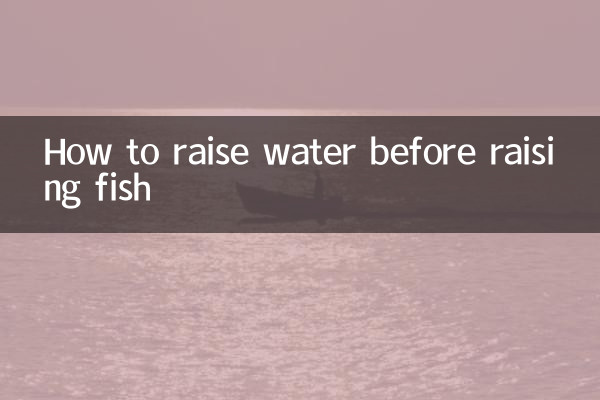How to raise water before raising fish: A complete guide to scientifically prepare the water quality of your fish tank
Fish farming is a hobby that requires patience and skill, and the steps of raising water are often key links that novices tend to overlook. The quality of water directly affects the health and survival rate of fish. This article will combine the popular fish farming topics and scientific methods on the Internet in the past 10 days to provide you with a detailed analysis of how to properly raise water before raising fish.
1. Why do we need to raise water before raising fish?

Tap water contains chlorine, heavy metals and other substances that are harmful to fish. Direct use can cause fish stress or even death. The purpose of raising water is to bring the water quality to a standard suitable for fish survival through aeration, filtration and cultivation of beneficial bacteria.
| Hazardous substances | harm | Removal method |
|---|---|---|
| Chlorine | Damage to fish gills, causing suffocation | Aerate for 24-48 hours or use dechlorinator |
| heavy metal | poisoning, organ damage | Activated carbon filtration or water conditioner |
| Ammonia/nitrite | blood poisoning | Set up nitrification system (takes 2-4 weeks) |
2. Specific steps for raising water
1. Basic water quality treatment (1-3 days)
• Pour tap water into the fish tank to start the filtration system cycle
• Use a heating rod to adjust the water temperature to the target temperature (according to the needs of the fish species)
• Add water stabilizer to remove chlorine and heavy metals
2. Establish a nitrification system (critical stage, takes 2-4 weeks)
| time | Changes in water quality indicators | Operation suggestions |
|---|---|---|
| Week 1 | Ammonia concentration rises | A small amount of fish food or nitrifying bacteria preparation can be added |
| Week 2 | Nitrite peak | Avoid water changes and keep filtration system running |
| Weeks 3-4 | Nitrates rise, ammonia/nitrites return to zero | The system is mature and small amounts of water can be changed |
3. Water quality testing and adjustment
Use test reagents to monitor the following key indicators:
| parameter | ideal range | Adjustment method |
|---|---|---|
| pH value | 6.5-7.5 (most freshwater fish) | pH adjuster/sunken wood/coral bone |
| hardness | 4-8°dH | Soften resin/add minerals |
| Ammonia/nitrite | 0mg/L | Strengthen filtration and extend water maintenance time |
3. Recently popular water maintenance skills (Top 5 most popular on the Internet)
1.Volcanic stone water cultivation method: Using porous volcanic stones to quickly cultivate nitrifying bacteria (hot topic on Douyin)
2.EM bacteria application: Domestic use of aquaculture technology to shorten the water maintenance cycle (Bilibili’s popular science video is a hit)
3.Intelligent monitoring: WiFi water quality detector for real-time monitoring (hot search product on e-commerce platforms)
4.plant filtration: Water cultivation method in aquatic plants tank, purifying water quality through aquatic plants (content of planting grass in Xiaohongshu)
5.Lao Shui speeds up: Add 1/3 of the old tank filter material to the new tank (highly praised answer on Zhihu)
4. Frequently Asked Questions
Q: Do I have to wait a month for water supply?
A: The traditional method requires 4 weeks to establish a complete nitrification system, but it can be shortened to 1-2 weeks using commercially available nitrifying bacteria preparations.
Q: Can I use mineral water to raise fish?
A: Not recommended. The mineral content of mineral water is unstable and lacks trace elements required by nitrifying bacteria.
Q: Do I need to turn on the lights during water maintenance?
A: You don’t need to turn on the lights for the first 3 days. After establishing the nitrification system, it is recommended to maintain regular lighting (6-8 hours/day).
5. Special water needs of different fish species
| fish type | Water temperature requirements | pH preference | Extra preparation |
|---|---|---|---|
| tropical fish | 24-28℃ | 6.0-7.0 | Thermostatic equipment required |
| goldfish | 18-24℃ | 7.0-7.5 | Enhance aeration |
| betta fish | 26-30℃ | 6.5-7.0 | Reduce flow intensity |
Conclusion:Water maintenance is the basis for successful fish farming, and scientific methods can avoid "new tank syndrome". It is recommended that novices complete a complete nitrogen cycle test before releasing fish and continue to pay attention to changes in water quality. remember"You can't raise good fish in a hurry", a good start is half the battle.

check the details

check the details